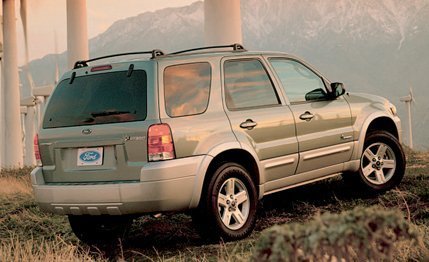Just to the tach’s left is a simple ammeter-like gauge indicating battery charge when the needle drops below center and electric assist when it rises. To get mileage numbers along with various screens depicting power flow and cumulative fuel economy, you must opt for the computer-navigation-audio system playing through a four-inch screen in the dash center.
Under the hood, the hybrid machinery is tightly integrated into a module that bolts to the back of the transverse 2.3-liter four (driver’s side) in a space not much bigger than an automatic would require. The hybrid transmission is made by Aisin-Warner, which also makes the Prius package, although the parts differ substantially in detail. Ford has combined the motor, the generator, and the brain module into a much tighter package than Toyota has, suggesting future use in more models.
The engine is a version of the Escape’s standard Duratec four adapted to the more efficient Atkinson cycle by closing the intake valve late, well after the compression stroke has begun. This increases the expansion ratio, which adds four-percent efficiency at a cost of lower torque. The engine’s 133 horsepower, supplemented by the 94-hp electric motor, gives performance similar to the nonhybrid 200-hp, 3.0-liter V-6 Escape, Ford says. We think that’s about right. Ford adds that the hybrid could cost up to $3500 more than a base four-cylinder Escape.
|
|
The 330-volt nickel-metal hydride battery pack, all 200 pounds of it, lives under the load floor behind the rear suspension. This is a heavy machine—3800 pounds for the all-wheel-drive version—requiring lots of expensive battery to get the 1.5 to 2.0 miles of “engine off” range (the distance the Escape can travel solely on the electric motor) claimed by Ford. We saw indicated speeds of nearly 30 mph on the battery alone. Electric power steering maintains assist while the engine is shut down. The air conditioner uses a belt drive from the engine, however, so cooling soon peters out.
Like other hybrids with CVTs, city fuel economy is better than on the highway. In traffic, this a peppy runabout. In the country, the CVT sensation dominates. Going uphill, the engine sings along at high revs quite independently of road speed. The burner is smooth enough, but the sound is “disconnected,” rather like that of an ancient Powerglide.
Cargo space is unchanged from the standard Escape. Warranty covers the hybrid-related parts for eight years or 100,000 miles. The interval between routine service stops is 10,000 miles.
This is a serious hybrid. And with fuel prices rising, it comes at the right moment.


Leave a Reply